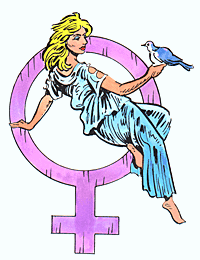Venus, Roman goddess
Aphrodite, Greek goddess
Venus, goddess of love and beauty, springtime and flowers
(second planet from the sun).

The second planet in distance from the Sun, the most brilliant object in the sky, she appears to welcome both the dawn and the dusk.

- Venus is the one goddess whose name was given to an important planet.
- Venus (Greek: Aphrodite; Babylonian: Ishtar) is the goddess of love and beauty.
- The planet is so named probably because it is the brightest of the planets known to the ancients.
- With a few exceptions, the surface features on Venus are named for female figures.
- This is the planet commonly called the “evening star” or the “morning star” (depending on which side of the sun it happens to be).
- It is considered the brightest and most beautiful object in the heavens next to the sun and moon, and is far brighter than any star.
- Originally the Greeks thought they were two different planets.
- The morning star was called phosphorus (light-bringer in Greek) because once it appeared in the eastern skies, the light of dawn would soon come.
- The evening star was called Hesperus (west in Greek) because it always shined in the western sky after sunset.
- Once the Greeks learned that Phosporus and Hesperus were really the same planet, they named it Aphrodite as befitted its beauty; and then the Romans changed the name to Venus which we now use.
- She is the mistress of Friday.
- Her symbol is said to represent a hand mirror.
A few scientific facts about Venus:
- Venus is the brightest object in our sky, except for the Sun and the Moon.
- The upper clouds of poisonous sulfuric acid swirl in a pattern of yellowish mists on Venus.
- Moving at speeds almost three times faster than winds in a hurricane, they race around the planet once every four days.
- People once imagined Venus as a Garden of Eden with lush vegetation, sparkling streams, and life.
- They regarded Venus as Earth’s twin because its size, mass, and density are so much like Earth’s; but, there the similarities end.
- Beneath the acid clouds is a planet we could not imagine in our wildest dreams because day and night, lightning and thunder flash and boom across a rainless sky.
- Earth’s clouds consist of water droplets but those upper clouds of Venus are droplets of sulfuric acid.
- The atmosphere is so dense we could nearly swim through it and the pressure is as strong as that which exists one kilometer below the surface of the oceans on Earth.
 You may return to the page of planet images from here.
|